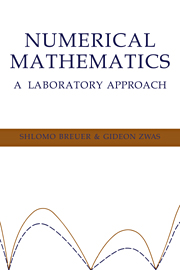Book contents
- Frontmatter
- Contents
- Preface
- Chapter 1 Mathematics in a numerical laboratory
- Chapter 2 Iterations for root extraction
- Chapter 3 Area approximations
- Chapter 4 Linear systems – An algorithmic approach
- Chapter 5 Algorithmic computations of π and e
- Chapter 6 Convergence acceleration
- Chapter 7 Interpolative approximation
- Chapter 8 Computer library functions
- Solutions to selected exercise
- Index
Chapter 4 - Linear systems – An algorithmic approach
Published online by Cambridge University Press: 05 June 2012
- Frontmatter
- Contents
- Preface
- Chapter 1 Mathematics in a numerical laboratory
- Chapter 2 Iterations for root extraction
- Chapter 3 Area approximations
- Chapter 4 Linear systems – An algorithmic approach
- Chapter 5 Algorithmic computations of π and e
- Chapter 6 Convergence acceleration
- Chapter 7 Interpolative approximation
- Chapter 8 Computer library functions
- Solutions to selected exercise
- Index
Summary
Introduction
In this chapter we present an algorithmic approach to the solution of systems of linear equations, another typical subject for the mathematical laboratory. No knowledge of matrices, vectors, and their underlying theory is presupposed, and thus the laboratory participants can handle this material even before the study of linear algebra.
After the development of an algorithm for the solution of “naive” systems of linear equations, special attention will be paid to problematic cases in which unrealistic answers with huge errors might be obtained. In particular, we shall discuss reasons for loss of accuracy, sensitivity to minor changes in the data, pivoting, scaling, and computational efficiency. By elaborating on each of these points by means of appropriate examples, we hope to present this traditionally abstract mathematical subject in a concrete, practical way that will be more meaningful to many students.
Coefficient tables
Systems of linear equations arise naturally in many practical areas such as mixing liquids, work and power calculations, electrical circuit computations, and marketing problems. It is particularly useful to demonstrate the subject under consideration by means of 3 × 3 systems (three equations and three unknowns). Such systems are not too large and cumbersome, but nevertheless constitute a case in which a pattern is revealed. Occasionally, when it is necessary for clarity, 4 × 4 and 2 × 2 systems will also be used.
- Type
- Chapter
- Information
- Numerical MathematicsA Laboratory Approach, pp. 61 - 86Publisher: Cambridge University PressPrint publication year: 1993



